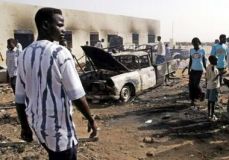Sudanese officials call for restraint following Soba violence
NAIROBI, May 20, 2005 (IRIN) — Sudanese and UN officials have called for calm after 30 people were killed when Sudanese security forces tried on Wednesday to forcibly relocate internally displaced persons (IDPs) from Soba Eradi camp, 30 km south of the Sudanese capital, Khartoum.

|
|
Sudanese refugees examine a destroyed vehicle at Soba Aradi camp, about 30 km (19 miles) south of the capital Khartoum, May 18, 2005. (Reuters) . |
In a statement, Jan Pronk, the special representative of the UN Secretary-General in Sudan, said he was “deeply concerned by reports of death in the Soba IDP area.”
The special representative called on the government of Sudan and all concerned parties to handle the situation with restraint, respect for basic human rights and according to the law to prevent further escalation of violence and loss of life.
“Reports have indicated that several people, both civilian and police, have been killed in the incident. The loss of life is tragic and deplorable,” Pronk said.
On Thursday, Sudanese President Umar al-Bashir extended his condolences to the Khartoum police over officers who were killed when IDPs attacked the Azhari police station on Wednesday.
He expressed his regret over the incident, during which 14 policemen and more than 20 IDPs reportedly were killed, stressing that the incident would “not affect the professional performance of the police.”
Sources said the unrest began when trucks loaded with armed men rolled into Soba Eradi, an IDP camp housing 26,000 people, at 5 a.m. (0200 GMT) on Wednesday morning.
The IDPs, who refused to be moved, gathered at a local bus station to protest, but at about 9:40 a.m. (06.40 GMT) the police officers opened fire on them, sources told IRIN.
The situation escalated as IDPs confiscated weapons from security forces, the sources added. Hundreds of IDPs fled the area, and unknown assailants set fire to the local police station and IDP shelters.
Meanwhile, Ahmad Muhammad Harun, the state minister at the Ministry of Interior, said in a statement that cases had been filed against a number of those accused in the incident.
He stressed that such incidents would not prevent the police from carrying out their duties in accordance with the law.
The police officers killed during the incidents were buried at Al-Safa quarter graveyard on Thursday in a funeral ceremony led by Khartoum State Governor Abd-al-Halim al-Muta’afi and Interior Minister Abd-al-Rahim Muhammad Husayn.
According to a May 2005 report of the health and nutrition situation in IDP settlements in Khartoum State – published by the Khartoum State Ministry of Health, the World Health Organization and the UNICEF – an estimated 325,000 IDPs are living in four official camps. Around 1.5 million are scattered in various squatter and peripheral areas.
The Sudanese government claims the demolitions, which have been taking place since the 1980s, are part of a larger re-planning programme that is meant to provide plots for residents and bring them vital services such as electricity and water.
Earlier, on 28 December 2004, Sudanese authorities demolished the Shikan IDP settlement north of Khartoum, displacing an estimated 1,700 families, or about 11,390 individuals.
Around 15 percent of the resident IDP population at Shikan was permitted to stay. The remaining 85 percent were removed to El Fateh, which translates as “the open area”, a desert area 38 km north of Omdurman, a city just north of Khartoum.
During the demolitions, security forces arrived without advance warning and loaded IDPs onto their trucks without allowing them to bring any personal belongings. Most arrived in El Fateh with only the clothes they were wearing.
The levelling of Shikan resulted in the destruction of all IDP property and infrastructure. The UN Office for the Coordination of Humanitarian Affairs said the authorities had made no prior preparations to ensure that Al Fateh was fit for human habitation. There was limited access to water and food, no health or education services and no electricity or sanitation system.
